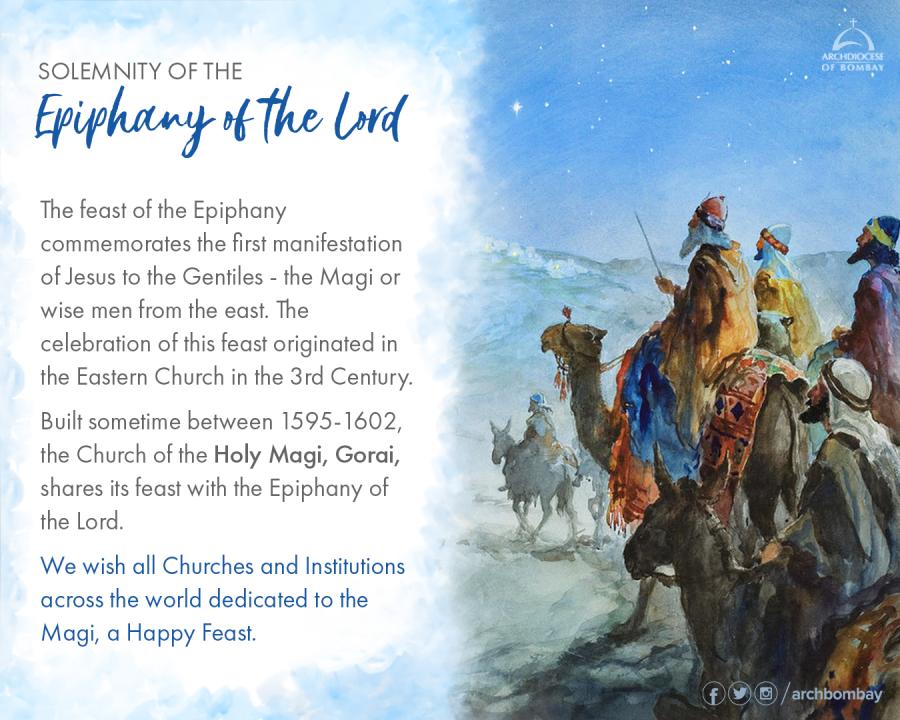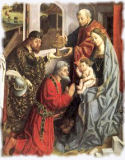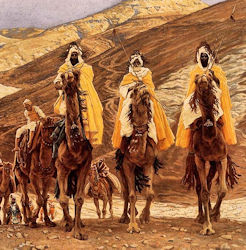6 January
(or the Sunday between 2-Jan & 8-Jan)
The Solemnity of The Epiphany of the Lord

The feast of the ‘Epiphany’ is the ‘Manifestation’ of Christ.
What makes the story of the wise men (Magi) fascinating is that they did not belong to the chosen people of Israel, yet they were among the first at the epiphany (manifestation of God). This opens our eyes to the fact that the experience of God cannot be limited to a particular people, place or manner.
COLLECT PRAYER
May the splendor of your majesty, O Lord, we pray, shed its light upon our hearts, that we may pass through the shadows of this world and reach the brightness of our eternal home. Through our Lord Jesus Christ, your Son, who lives and reigns with you in the unity of the Holy Spirit, God, for ever and ever.

Today the Church celebrates the Solemnity of the Epiphany. “The Lord and ruler is coming; kingship is his, and government and power.” With these words, the Church proclaims that today’s feast brings to a perfect fulfillment all the purposes of Advent. Epiphany, therefore, marks the liturgical zenith of the Advent-Christmas season. — Pius Parsch
The Solemnity of the Epiphany is celebrated either on January 6 or, according to the decision of the episcopal conference, on the Sunday between January 2 and January 8.
The young Messiah is revealed as the light of the nations.
Yet, as the antiphon for the Magnificat at Second Vespers reminds us, three mysteries are encompassed in this solemnity: (1) the adoration of the Christ Child by the Magi, (2) the Baptism of Christ and (3) the wedding feast at Cana.
Extra candles and/or lamps may be placed around the sanctuary and in other parts of the church to honor Christ revealed as the Light of the Gentiles (Ceremonial of Bishops). It is customary to replace the images of the shepherds at the crib with the three Magi and their gifts. — Ceremonies of the Liturgical Year, Msgr. Peter J. Elliott, Ignatius Press.

Solemnity of the Epiphany – usually Day Twelve of Christmas

Epiphany is a large celebration, especially in Spanish speaking countries. Things look different around the household: the infant Jesus in the manger now has a small gold crown and is wearing regal robes. The figures of the wise men have reached Bethlehem, completing the nativity scene.
The Church extends itself on Epiphany to the homes of the faithful. The custom of blessing the home on this day probably originated from these words in the Gospel, “And entering into the house, they found the Child with Mary, His Mother, and falling down they adored Him.” The priest blesses the house if he can be present, but if not, the father of the family may do so.
- Day Twelve activity (Epiphany Party)
- Day Twelve recipe (Twelfth Day Cake)
- Blessing of the Home and Household on Epiphany

The feast of the Epiphany, which was kept in the East and in certain Western Churches before being observed in Rome, seems to have been originally a feast of the nativity; January 6, for those churches where it was kept, was the equivalent of Christmas (December 25) in the Roman Church. The feast was introduced at Rome in the second half of the sixth century and became the complement and, so to say, the crown of the Christmas festival.
Epiphany means manifestation. What the Church celebrates today is the manifestation of our Lord to the whole world; after being made known to the shepherds of Bethlehem He is revealed to the Magi who have come from the East to adore Him. Christian tradition has ever seen in the Magi the first fruits of the Gentiles; they lead in their wake all the peoples of the earth, and thus the Epiphany is an affirmation of universal salvation. St. Leo brings out this point admirably in a sermon, read at Matins, in which he shows in the adoration of the Magi the beginnings of Christian faith, the time when the great mass of the heathen sets off to follow the star which summons it to seek its Saviour.
That is the meaning, too, of the wonderful prophecy from Isaias which the liturgy appoints to be read in the first nocturn at Matins and at the Epistle of the Mass. This same thought of universal redemption the Church returns to as she sings, in the antiphon to the Magnificat at 2nd Vespers, applying the words to herself, of the union with Christ typified by the wedding feast at Cana, by the baptism of her children foreshadowed by that of Christ in the waters of the Jordan. Formerly the Epiphany was an additional day for solemn baptisms.
Source: Catholic Culture
